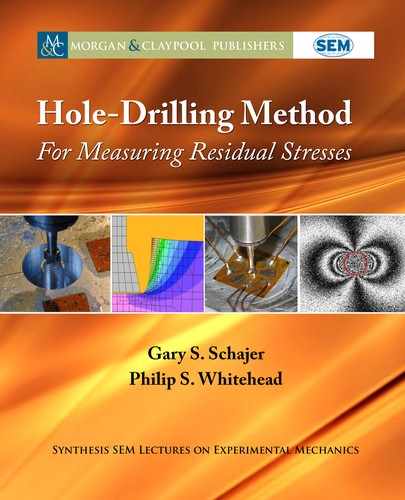4.7. GAUGE DATA 85
4.7 GAUGE DATA
It is recommended that gauge data are recorded on a standard form. is form should contain
the following information:
• the date and time of the test;
• the specimen identification details (material, surface treatment, etc.);
• the material properties (Young’s modulus and Poisson’s ratio);
• the gauge identification number;
• the drilling machine identification number (if appropriate);
• the strain measurement/recording instrument identification number;
• the strain gauge type, lot number and gauge factor;
• the array of hole depths and relaxed strains at those depths; and
• the final hole diameter (and depth, if required).
After completion of all measurements and associated documentation, the residual stress
values corresponding to the measured strains can be calculated as described in Chapter 5.
e procedures described in this chapter are suitable for the majority of routine hole-
drilling residual stress measurements. However, it often happens that some feature of the spec-
imen or measurement objective requires a procedural variation. Such variations can be accom-
modated within the basic hole-drilling technique providing that care is taken to preserve the
integrity of the overall measurement process. Chapter 6 describes some example applications
that require procedural adaptations to meet their measurement objectives.
4.8 FURTHER READING
• ASTM-E837 (2013). Determining Residual Stresses by the Hole-drilling Strain-gage
Method. ASTM Standard Test Method E837-13a. American Society for Testing and Ma-
terials, West Conshohocken, PA.
• Rendler NJ, Vigness I (1966). Hole-drilling Strain-gage Method of Measuring Residual
Stresses. Experimental Mechanics, 6(12):577–586.
• Vishay Measurements Group, Inc. (1993). Measurement of Residual Stresses by the Hole-
drilling Strain-gage Method. Tech Note TN-503-6. Vishay Measurements Group, Inc.,
Raleigh, NC. 16pp.
86 4. STRAIN GAUGE TECHNIQUE: METHOD DESCRIPTION
• Grant PV, Lord JD, Whitehead PS (2002). e Measurement of Residual Stresses by the
Incremental Hole Drilling Technique. Measurement Good Practice Guide, No. 53, National
Physical Laboratory, Teddington, UK.
• Vishay Precision Group, Inc. (2011). Surface Preparation for Strain Gauge Bonding. In-
struction Bulletin B-129-8, December 19, 2011.
• Vishay Precision Group, Inc. (2011). Strain Gage Installations with M-Bond 200 Adhe-
sive. Instruction Bulletin B-127-14, October 14, 2011.
• Vishay Precision Group, Inc. (2010). Strain Gage Soldering Techniques. Application Note
TT-609, November 13, 2010.
• Vishay Precision Group, Inc. (2010). e ree-wire Quarter-bridge Circuit. Application
Note TT-612, November 14, 2010.
..................Content has been hidden....................
You can't read the all page of ebook, please click here login for view all page.
